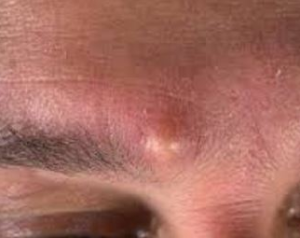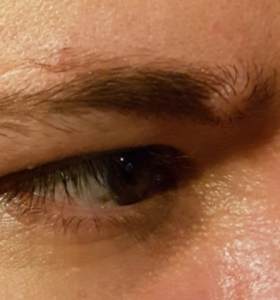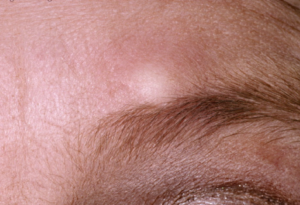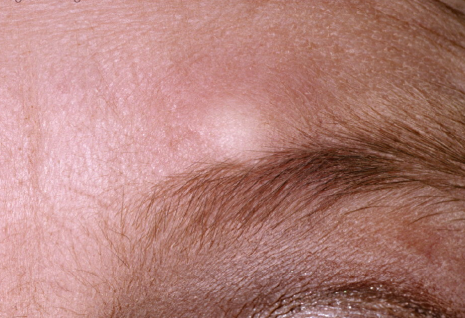Lump on eyebrow can be hard, small and painful. This post provides you with information on the causes and how you can get rid including treatment. Could it be cancer? Find out more.

Lump in eyebrow causes
Lump on eyebrows can be as a result of different condition. The lumps can also be a good sign of an underlying medical condition. Left untreated, a bumps, cyst or lump appearing on your eyebrow could lead to complication on your eyes or the face. Below are some of the possible causes of these lumps.
If you notice a lump on your eyebrow last for more than a day, you need to have it checked by a dermatologist. The following are the possible causes of lump on the eyebrow.
- Sebaceous cyst, which is typically a swelling in the skin arising in the sebaceous glands. It is a bump as filled with yellowish sebum. These bumps are painless and can heal on their own.
- Ingrown eyebrow hair, common in people with coarse and curly hair, these bumps are formed when hair strand fail to penetrate the skin or grown underneath the skin surface. Also called razor bumps, the bumps can be accompanied with the infection of the hair follicles or not.
- Skin cyst are noncancerous small bumps beneath the skin. These cyst can appear anywhere on the skin, they are however common on the face, neck, and trunk.
- Folliculitis is the inflammation of the hair follicles. These are the pores on the skin where hair strands penetrate the skin from. When infected, the hair follicles can become clogged with sebum and dead skin cells.
- Lipoma, these are benign tumor composed of body tissue. Lipoma are the most common benign form of soft tissue tumor. These bumps are soft to touch, usually movable and generally painless
- Other causes include: Neurofibroma, Keratosis pilaris, Benign Dermatofibromas, Keratacanthom, Melanoma, skin cancer and eyebrow piercing
Lump on eyebrow cancer
Lump, cyst, and bumps appearing on the face and on eyebrows can also be as a result of skin cancer. According to the National Health Service UK, skin cancer is one of the most common cancer in the world. Non-melanoma skin cancer, a common type of cancer, refers to a group of skin cancer that slowly develops in the upper layer of the skin.
A less common type of skin cancer known as melanoma can be more serious. According to available statistic, non-melanoma skin cancer affects approximately 100000 people each year in the United Kingdom alone, of this number, there are more men than women. The condition is common in the elderly than in young people.
A lump is the first sign of non-melanoma skin cancer. The lump will continue to persist after a few weeks and slowly progresses over months or sometimes years. When the lump appearing on eyebrow is cancerous, the lump will be red and firm and sometimes turn into ulcers, cancerous patches will usually be flat and scaly.
Apart from the eyebrows, non-melanoma skin cancer will most often develop on areas of the skin regularly exposed to the sun. These areas will include the face, hands, shoulders, upper chest and back. With skin cancer, the common symptom will include the following:
- A sore of spot that does not heal fast
- An ulcer appearing on the skin
- A small, slow-growing, shiny and red lump
- Itchy red patches on the skin
If you notice any of the symptoms last for more than 3 weeks, you will need to have them checked out by a dermatologist or any professional health care provider. They will run some tests and when you are diagnosed with skin cancer, different treatment options will be discussed with you.
Cancer treatment will depend not only on the type of cancer but also on the stage the cancer is at. Treatment can then include either, chemotherapy where strong chemical drugs are used to kill and suppress the cancerous cells in your eyebrows, radiation therapy when these cells are destroyed physically with high radiation ultraviolet rays or surgery. With surgery, the tumor and surrounding tissues are removed during an operation.
Surgery is the oldest type of cancer therapy and remains an effective treatment from many types of cancer today [cancer.net]. The goal for surgery will vary, however, surgery is used for the following reasons:
- To diagnose cancer,
- Find out the location of cancer
- To remove some or all of the cancerous tumor
- Find out if cancer has spread or is affecting the functions of other organs in the body
- To restore appearance on the function of the affected organ
- Finally, to relieve the side effects
- To prevent or reduce the risk of cancer spreading
- To control symptoms and extend life
Lump on eyebrow bone
Our bones are living and growing tissues made mostly of collagen. Collagen is protein that provides the soft framework. Collagen also provides the mineral calcium phosphate that adds strength and hardens the framework.
A lump on eyebrow bone can be hard and painful and will in most cases come and go. To some people, however, the bump will be small and painless. The lump in eyebrow bone can appear to anyone regardless of age and gender. A possible cause of these bumps can include the following:
Osteoma
An osteoma or osteomata in the plural is a new piece of bone that grows on another piece of bone. This is most common on the skull but could happen on other bones. Osteoma is a benign tumor. When the bone tumor grows on the other bone, it is known as homoplastic osteoma, when it grows on other tissues, it is called heteroplastic osteoma.
Osteoma represents the most common benign neoplasm of the nose and paranasal sinuses. The cause of osteoma is uncertain, commonly accepted theories propose embryological, traumatic or infectious causes.
Large craniofacial osteoma may cause facial pain, headache, and infection due to obstructed nasofrontal duct [Wikipedia]. It is unclear whether surgery help with the headaches and other symptoms, however, if the tumor causes pressure then removing it might help.
Cancer
As mentioned, of all the types of cancer, skin cancer is the most common. Cancer is a disease caused by an uncontrolled division of abnormal cells in a part of the body. A malignant growth or tumor resulting from the division of abnormal cell can result on any part of the body. A lump caused by cancer can be small and painless or large and painful.
Early treatment and diagnosis can help prevent the spread and risk of cancer. Depending on the type and stage the cancer is at, treatment may involve either radiation therapy chemotherapy or surgery. All this option will be discussed to you by your doctor.
Benign tumor
A lump on eyebrows caused be cancer can either be benign or malignant. A benign tumor is a mass of cell or tumor that lacks the ability to invade neighboring tissue. With this, a benign tumor is not defined as cancerous.
On the other hand, a malignant tumor is that which invades the surrounding tissues. It is usually capable of producing metastases. Metastasis is development of the secondary malignant growths at a distance from the primary site of cancer.
Osteochondroma
Osteochondroma is the most common benign tumor of all bones. This tumor takes the form of cartilage-capped bony projections or outgrowth on the surface of the bones. The condition is characterized as a type of overgrowth that can occur in any bone where cartilage forms bone.
The condition is rare, but it does occur. The growth is not cancerous and is common in children and in adults. Since n symptoms are common, the tumor is more likely to be noticed when the child has a bump or reports pain.
The actual cause of the condition is not known, there however theories that say the tumor is maybe a result of genetic abnormalities. Clinicians and scientist are currently studying this condition its origin. In most of the reported cases, osteochondroma shows no symptoms, however, depending on the location and size of the bone growth, some of the symptoms would include the following:
- Severe pain
- Nerve compression causing weakness of muscles
- A visible bump or lump under the skin
- Deformity
- Growth disturbances
Lump below eyebrow swollen eye
With a lump on eyebrows, it is possible for the eye to swell. This can be painful and could result in difficulties in seeing. Urgent diagnosis and treatment of the underlying cause of the lump is required. The aim of the treatment will thus not only be to relieve the symptoms but also to prevent the spread of the infection to other parts of the body.

A swollen eye can more likely to be as a result of a chalazion. A chalazion according to the American Optometric Association is a slowly developing lump that forms due to blockage and swelling of an oil gland in the eyelid. It is generally not an infection.
A chalazion will often start out as a very small red, tender, swollen area of the eyelid. In a few days, it may change to a painless slow-growing lump the size of a pea. Most people confuse a chalazion with a stye, the difference is, whereas a stye is an infection of the oil gland in the eyelid, a chalazion is not. A stye produces a red, swollen, painful lump on the edge or the inside of the eyelid and usually occurs closer to the surface of the eyelid than chalazia.
Chalazion causing the swelling of the eye will have the following symptoms:
- Painless lump in the upper or lower eyelid
- Thickening of the fluid in the oil glands of the eyelid
- Tearing and mild irritation
- Blurred vision when the chalazion is large enough to press against the eyeball
- The bump may disappear within several weeks though they might often recur
Lump on forehead above eyebrow
Different conditions could lead to the development of a lump on the forehead above the eyebrow. The lump on the forehead can appear on anybody regardless of age, gender and skin complexion. The lumps are however common in old people and will vary in causes from one person to the other.
The characteristics of the lump will also vary in terms of size, shape, and color. All this will depend on the underlying cause of the lump. Some people will have small and painless bumps, others will have large and painful bumps, and for some, the bumps might be malignant whereas to others the bumps are mostly benign.
Dr. Amil Shah a plastic surgeon, says most cases of a hard lump on the forehead above the eyebrow are attributed to osteoma. Osteoma is hard, bony growth in the skull. The growth is rare and in most cases, they are not cancerous. The National Library of Medicine says the condition may be hereditary of form at birth.
The other common cause of a lump on the forehead is hard tissue injury on the forehead. This kind of injuries can also cause hard or small bumps to appear above eyebrows. A hard tissue injury refers to the injury of the bone tissue. This are kinds of injury that causes the loss of continuity in the substance of the bone. They include fractures and dislocation. Urgent medical attention is required for this kind of injuries.
Hard lump under eyebrow
A hard painless lump on either eyebrow can be painful and will in most cases come and go. When this is the cases, a painful lump appearing on your forehead is most likely to be a sebaceous cyst, a benign growth or lipoma.

A sebaceous cyst also known as an epidermoid cyst is a non-cancerous swelling under the skin. The cyst is in usually lined by packed outer skin cell. The content of the cyst are dead skin cells and sebum which is an oily secretion of the sebaceous glands. These lumps or cyst will usually become tender or enlarge under conditions such as stress, increased activity, mechanical irritation, and condition such as diabetes or other current illness.
Sebaceous cyst under eyebrows is thus often as a result of swollen hair follicles or skin trauma. These bumps are not dangerous and will often disappear on they own, surgical removal is however recommended when the cyst grow too large, become tender or interfere with everyday life.
The other possible cause of the hard bumps under eyebrow would be a lipoma. A lipoma is another benign tumor composed of adipose tissue, which is basically body fat. Of all the benign form of soft tissue tumor, a lipoma is the most common. These growths are soft to touch, usually movable and are generally painless.
No treatment is required for lipoma, However, when the growths have become painful and large, then a steroid injection or surgical removal can be prescribed. If you notice the lump under eyebrow become painful or larger, you need to consult a doctor as soon as possible.
Painful Lump in eyebrow
Pan is a common characteristic of different growth or disorder appearing not only on your eyebrow but on any part of your body. Lump on eyebrow can either be painful or not. All this will depend on what the underlying cause of the bump is.
Different characteristic of the bump such as the position the bump appears on, the size of the bump, whether or not the bump is popped and if the bump is infected or not. For the record, an infected bump is more painful than that which is not. Pain can thus be used as a sign of infection.
A painful lump in eyebrow can thus be as a result of a condition such as Acne vulgaris, Melanoma, Folliculitis, Eye infection, Skin cancer and Skin cyst. If topical creams and painkillers won’t help with the pain, have a dermatologist check it out.
Small lump near an eyebrow headache
According to WebMD symptom checker, there are close to 80 possible conditions associated with a headache, lump or bulge. The symptoms checker helps provide a better understanding of the causes and treatment of these related conditions.
Headache accompanying the small lumps on eyebrow can be caused by any of the following:
- Tension headaches
- Trauma or injuries
- Aseptic meningitis
- Acute stress reaction
- Excessive caffeine use
- Caffeine withdrawal
- Migraine headache
Treatment for Lump on eyebrow
Depending on the underlying cause of the lump on eyebrow, the symptoms and treatment will vary. Not all the underlying causes of these lumps require treatment to get rid of them. The treatment for this bump will also depend on how large the lump is, whether or not the bumps is painful. Other symptoms will include itching, irritation inflammation, and swelling.
For enlarged lump in eyebrow your dermatologist might prescribe a corticosteroids injection, the topical ointment can be used for symptoms such as inflammation, swelling, irritation, and itching. For severe pain caused by the lumps, you might need to some over the counter painkillers.
Oral or topical antibiotics can be used for infected lumps on the eyebrow. Wash you face with an antiseptic solution to keep the bumps free from bacteria.
How to get rid of Lump on eyebrow
Most of the cause of lump are not serious and most will even heal on their own without treatment. For some of the symptoms like irritation, itching, swelling and inflammation natural home remedies can be used to relieve them.
You can try the following natural remedies:
a) Apple cider vinegar
Of the natural remedies, apple cider vinegar has strong anti-fungal and antiseptic properties. It also has antimicrobial qualities which make it suitable for a cleansing agent. Apple cider vinegar is a good choice for an infected sebaceous cyst on eyebrow or other parts of the body.
To use apple cider as a remedy:
- Soak a cotton ball in a solution of apple cider vinegar
- Apply the solution and hold it on for some minutes
- For those with sensitive skin, make sure to dilute the vinegar
- Repeat the process twice or thrice a day
b) Warm or cold compress
To speed the healing and drainage of a sebaceous cyst, apply a moist heat gently on the lump. Heat dilates your blood vessels, this improves the transportation of nutrients to the affected site which heals the damaged skin faster.
All you need is a clean towel and a bowl of warm water. Apply a warm compress on the cyst for 10 minutes twice or thrice day.
c) Tea tree oil
When the underlying cause of the bumps is the overproduction of sebum, which leads to clogged pores that in turn give rise to cystic acne. Tea tree oil is the best remedy for this, it is a known anti-microbial agent with excellent anti-inflammatory and anti-bacterial effects.
Sources and references:
- http://www.webmd.com/skin-problems-and-treatments/guide/cysts-lumps-bumps#1
- http://www.rightdiagnosis.com/sym/eyebrow_lump.htm
- https://www.axappphealthcare.co.uk/health-information/expert-help/small-lump-above-eyebrow/
- http://www.wisegeek.org/what-are-the-common-causes-of-an-eyebrow-cyst.htm
- http://www.cancer.net/navigating-cancer-care/how-cancer-treated/surgery/what-cancer-surgery
